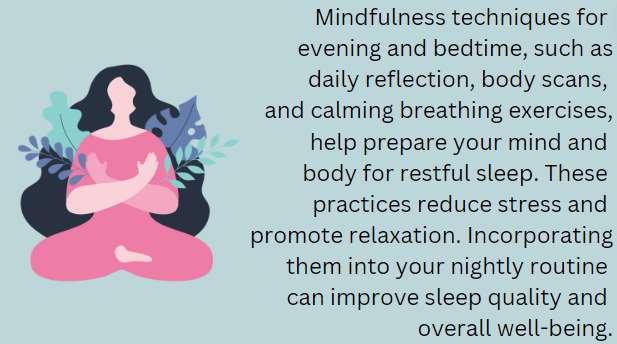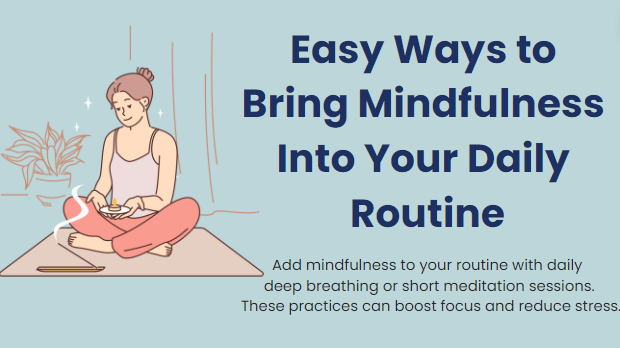In our fast-paced world, finding moments of peace and presence can seem like a daunting task. However, incorporating mindfulness into your daily routine doesn’t have to be complicated or time-consuming. This article will explore simple and effective ways to cultivate mindfulness throughout your day, helping you reduce stress, improve focus, and enhance overall well-being.
What is Mindfulness?
Mindfulness is the practice of being fully present and engaged in the current moment, without judgment. It involves paying attention to your thoughts, feelings, and surroundings with openness and curiosity.
Benefits of Mindfulness
Before diving into the practical ways to incorporate mindfulness, let’s look at some of its key benefits:
- Reduced stress and anxiety
- Improved focus and concentration
- Enhanced emotional regulation
- Better sleep quality
- Increased self-awareness
- Improved relationships
- Greater overall well-being
| Quick Mindfulness | Benefits |
|---|---|
| Stress Reduction | Better Focus |
| Emotional Balance | Improved Sleep |
See also>> Quick Snacks That Won’t Ruin Your Diet
Easy Ways to Bring Mindfulness Into Your Morning Routine
1. Mindful Waking
Start your day with intention by practicing mindful waking:
- Take a few deep breaths as soon as you wake up
- Notice the feeling of your body against the bed
- Observe any thoughts or feelings without judgment
2. Mindful Stretching
Incorporate gentle stretches into your morning routine:
- Focus on the sensations in your body as you stretch
- Notice areas of tension and consciously relax them
- Breathe deeply and slowly as you move
3. Mindful Eating
Transform your breakfast into a mindful experience:
- Eat without distractions (no phone, TV, or reading)
- Pay attention to the colors, smells, and textures of your food
- Chew slowly and savor each bite
Mindfulness Practices for Work or Study
4. Mindful Breathing Breaks
Take short breaks throughout your day to practice mindful breathing:
- Set a reminder every hour
- Take 5-10 deep breaths, focusing solely on your breath
- Notice how your body feels before and after the practice
5. Mindful Task Transitions
Use the moments between tasks as opportunities for mindfulness:
- Take a few deep breaths before starting a new task
- Set a clear intention for the next activity
- Notice any thoughts or feelings about the upcoming task
6. Mindful Listening
Practice mindful listening during conversations and meetings:
- Give your full attention to the speaker
- Notice when your mind wanders and gently bring it back
- Observe your own reactions without immediately responding
| Mindfulness Practices | Benefits |
|---|---|
| Breathing Exercises | Stress Reduction |
| Meditation | Improved Focus |
| Mindful Listening | Emotional Balance |
| Body Scan | Better Sleep |

Incorporating Mindfulness Into Daily Activities
7. Mindful Walking
Transform your daily walks into mindfulness practice:
- Pay attention to the sensation of your feet touching the ground
- Notice the movement of your body as you walk
- Observe your surroundings with curiosity
8. Mindful Chores
Bring mindfulness to routine tasks like washing dishes or folding laundry:
- Focus on the physical sensations of the task
- Notice the sounds, smells, and textures involved
- Observe any thoughts that arise without getting caught up in them
9. Mindful Technology Use
Practice mindfulness while using devices:
- Take a breath before checking your phone or opening your computer
- Notice the urge to check devices and pause before acting on it
- Set intentional limits on screen time
See also>> How Exercise Helps You Beat Stress and Feel Good
Mindfulness Techniques for Evening and Bedtime
10. Mindful Reflection
End your day with a brief mindful reflection:
- Review your day without judgment
- Notice three things you’re grateful for
- Acknowledge any unresolved feelings or thoughts
11. Mindful Body Scan
Practice a body scan before sleep to release tension:
- Lie comfortably in bed
- Slowly bring your attention to each part of your body, from toes to head
- Notice any areas of tension and consciously relax them
12. Mindful Breathing for Sleep
Use mindful breathing to prepare for sleep:
- Focus on your breath as you lie in bed
- Count your breaths or use a mantra like “breathing in, I relax; breathing out, I let go”
- Gently return your focus to your breath if your mind wanders
| Mindfulness Techniques Before Bed | Benefits |
| Daily Reflection | Reduces Stress |
| Body Scan | Enhances Relaxation |
| Breathing Exercises | Improves Sleep Quality |
| Progressive Muscle Relaxation | Alleviates Tension |

Overcoming Common Mindfulness Challenges
Dealing with a Wandering Mind
It’s normal for your mind to wander during mindfulness practice. When this happens:
- Acknowledge the thought without judgment
- Gently redirect your attention back to your chosen focus
- Remember that noticing your mind has wandered is part of the practice
Making Time for Mindfulness
If you struggle to find time for formal mindfulness practice:
- Start with just 1-2 minutes a day
- Integrate mindfulness into existing routines (e.g., brushing teeth, commuting)
- Use “micro-practices” throughout the day (e.g., taking three mindful breaths)
Staying Consistent
To maintain a regular mindfulness practice:
- Set realistic goals
- Use reminders or apps to prompt practice
- Join a mindfulness group or find an accountability partner
See also>> Why Taking Breaks Can Improve Your Mental Health
FAQs
Q: How long does it take to see benefits from mindfulness practice?
A: While some people report feeling calmer after just one session, noticeable benefits typically emerge after several weeks of regular practice. Consistency is key.
Q: Do I need to meditate to practice mindfulness?
A: While meditation is a powerful mindfulness tool, it’s not the only way. Many of the techniques described in this article allow you to practice mindfulness without formal meditation.
Q: Can mindfulness help with anxiety?
A: Yes, research has shown that regular mindfulness practice can help reduce symptoms of anxiety by promoting relaxation and changing how we relate to anxious thoughts.
Q: Is mindfulness religious or spiritual?
A: While mindfulness has roots in Buddhist meditation, modern mindfulness practices are secular and can be practiced by anyone, regardless of religious or spiritual beliefs.
Q: Can children practice mindfulness?
A: Absolutely! There are many age-appropriate mindfulness activities for children that can help them develop emotional regulation and focus.
Conclusion
Incorporating mindfulness into your daily routine doesn’t require drastic changes or hours of meditation. By implementing these simple practices throughout your day, you can cultivate greater awareness, reduce stress, and enhance your overall well-being. Remember, mindfulness is a skill that improves with practice, so be patient and kind to yourself as you develop this valuable habit.
